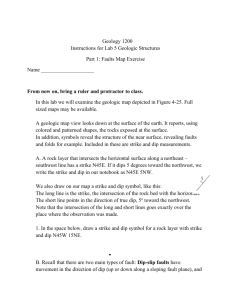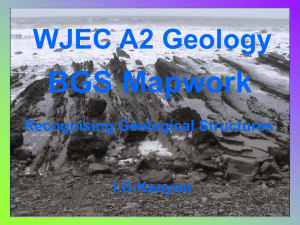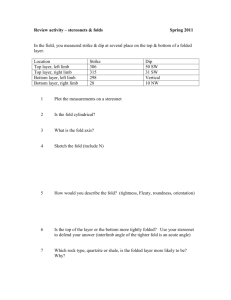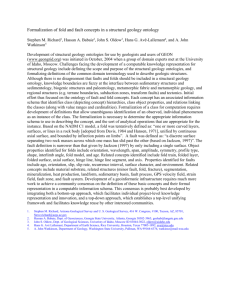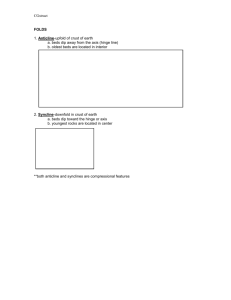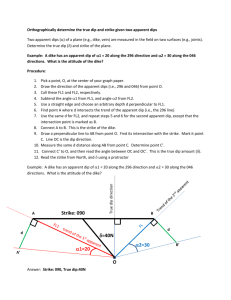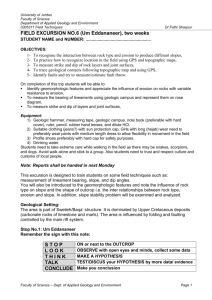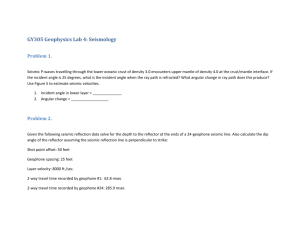Lab 10: Geologic Structures, Maps and Block Diagrams Lab
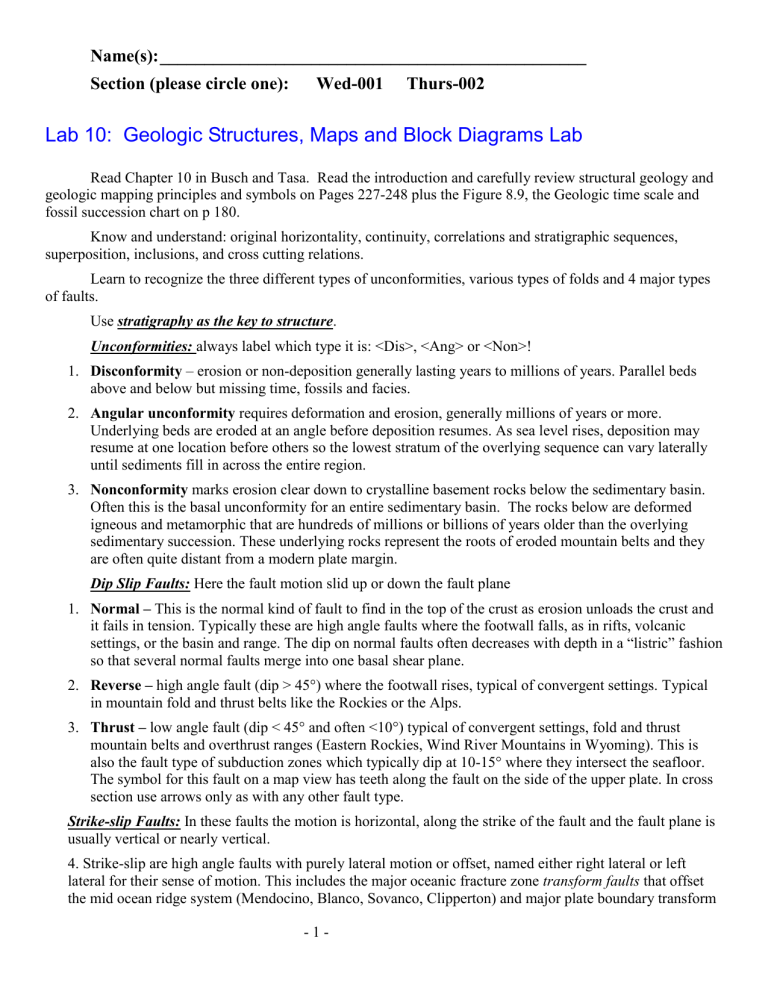
Name(s): ________________________________________________
Section (please circle one): Wed-001 Thurs-002
Lab 10: Geologic Structures, Maps and Block Diagrams Lab
Read Chapter 10 in Busch and Tasa. Read the introduction and carefully review structural geology and geologic mapping principles and symbols on Pages 227-248 plus the Figure 8.9, the Geologic time scale and fossil succession chart on p 180.
Know and understand: original horizontality, continuity, correlations and stratigraphic sequences, superposition, inclusions, and cross cutting relations.
Learn to recognize the three different types of unconformities, various types of folds and 4 major types of faults.
Use stratigraphy as the key to structure .
Unconformities: always label which type it is: <Dis>, <Ang> or <Non>!
1.
Disconformity – erosion or non-deposition generally lasting years to millions of years. Parallel beds above and below but missing time, fossils and facies.
2.
Angular unconformity requires deformation and erosion, generally millions of years or more.
Underlying beds are eroded at an angle before deposition resumes. As sea level rises, deposition may resume at one location before others so the lowest stratum of the overlying sequence can vary laterally until sediments fill in across the entire region.
3.
Nonconformity marks erosion clear down to crystalline basement rocks below the sedimentary basin.
Often this is the basal unconformity for an entire sedimentary basin. The rocks below are deformed igneous and metamorphic that are hundreds of millions or billions of years older than the overlying sedimentary succession. These underlying rocks represent the roots of eroded mountain belts and they are often quite distant from a modern plate margin.
Dip Slip Faults: Here the fault motion slid up or down the fault plane
1.
Normal – This is the normal kind of fault to find in the top of the crust as erosion unloads the crust and it fails in tension. Typically these are high angle faults where the footwall falls, as in rifts, volcanic settings, or the basin and range. The dip on normal faults often decreases with depth in a “listric” fashion so that several normal faults merge into one basal shear plane.
2.
Reverse – high angle fault (dip > 45°) where the footwall rises, typical of convergent settings. Typical in mountain fold and thrust belts like the Rockies or the Alps.
3.
Thrust – low angle fault (dip < 45° and often <10°) typical of convergent settings, fold and thrust mountain belts and overthrust ranges (Eastern Rockies, Wind River Mountains in Wyoming). This is also the fault type of subduction zones which typically dip at 10-15° where they intersect the seafloor.
The symbol for this fault on a map view has teeth along the fault on the side of the upper plate. In cross section use arrows only as with any other fault type.
Strike-slip Faults: In these faults the motion is horizontal, along the strike of the fault and the fault plane is usually vertical or nearly vertical.
4. Strike-slip are high angle faults with purely lateral motion or offset, named either right lateral or left lateral for their sense of motion. This includes the major oceanic fracture zone transform faults that offset the mid ocean ridge system (Mendocino, Blanco, Sovanco, Clipperton) and major plate boundary transform
- 1 -
faults like the San Andreas, Queen Charlotte-Fairweather, Alpine, Anatolian etc. Smaller scale strike-slip faults are found as tears between thrust panels in fold and thrust belts like the foothills of the Canadian
Rockies. Strike slip transform faults take up differential rotation when blocks of crust slide or shear past each other.
Oblique-slip Faults: In these faults the motion is at an angle to both the horizontal and to the steepest line of descent in the fault plane. The motion is oblique to the fault plane and is a combination of horizontal, along the strike and vertical along dip motions. The fault planes are often curved and this type of faulting occurs along curved contacts of mountain belts or where strike slip faults cut mountain ranges or are otherwise affected by rocks of different strengths on both sides of the fault.
Strike and Dip and other common map symbols:
Please refer to the various map symbols and their definitions on p. 230-231. Strike is the map direction of a horizontal line formed from the intersection of a plane of rock and the surface of the earth. It is measured in degrees clockwise from North at 0° in a circle with 360°.
Strike is always parallel to the long direction of bedded formations on a geological map.
Dip is perpendicular to the strike line and points in the downhill direction. It is measured in degrees below the horizontal ranging from 0° to a maximum of 90°.
Special cases: horizontal beds are denoted with an plus sign + or an X in a circle (also called quaquaversal dip). Vertical beds like intrusive dykes are denoted with a short cross bar perpendicular to the strike symbol
| .
With bedded rocks it is possible to tell the way up from the succession of fossils or local stratigraphy and also from cross beds, fossils, pebble imbrications and other sedimentary structures such as mud cracks or graded beds. Because of this it is possible to tell when beds are upside down. We use special symbols for overturned strike and dip, fold axes etc. that pay attention to the overturning as well as angles. These symbols look like bent over croquet wickets or capital U’s or their upside down equivalent. The open end of the line always points down dip.
Fault traces are a bold line with either U and D for up and down on respective sides for normal and reverse faults or a later pair of arrows pointing the direction of strike slip motion (to the right or to the left) on top of the map. For faults in cross section always use arrows to indicate the relative sense of motion across the fault.
For Thrust faults, a series of triangular teeth is drawn on the edge of the upper plate.
When a fault has a compound motion that is neither purely dip slip nor purely strike slip, it is termed an oblique slip fault .
Fold axis symbols:
Anticlines have outwards facing arrows, antithetic to the strike along the fold hinge.
Synclines have inwards facing arrows, synthetic to the strike, along the fold hinge.
Unconformites:
Hiatus and unconformities are denoted by bold wavy lines between stratigraphic packages, whether these occur on a cross section or along a map surface.
Activity 10.1: Introduction to Structural Geology
A. Examine the geological Map (top or plan view) from fig. 10.1. (sideways here to fit on page!) Do your work on the second Map below.
- 2 -
1. Add symbols for strike and dip to each of the 3 formations. Make sure you use the correct versions of the strike and dip symbols, and label the yellow formation with the correct dip angle. (3)
2. The geological contact between the yellow and the blue bed is a structure of some kind.What are the 2 possibilities? ___________________________________________________________________________
__________________________________________________________________________________ (2)
3. If you encounter a sudden change of dip like this between adjacent beds, what kind of geological evidence do you look for to resolve which of the 2 possible types of structures it is?
_____________________________________________________________________________________
____________________________________________________________________________________ (2)
- 3 -
B. For each of the 2 maps below, record the strike direction (azimuth with respect to North). Then use the Rule of V’s to determine the dip direction and sketch this in on the cross sections below. Here the dip angle is approximate as we do not have the topography nor the stream gradient to calculate a specific angle. (7)
C. The following aerial photograph is 1 km square and taken from directly above the center of the photo in the
Great Basin. Dipping strata have outcrop patterns that resemble chevrons on a Sergeant’s sleeve. As these beds differentially erode, the contacts between sandstones and shales obey the rule of V’s.
1. Circle a “V” shaped stream notch.
2. Add a strike and dip symbol on the face of a chevron.
3. What is the strike azimuth (degrees away from north)?
- 4 -
(1)
(2)
(2)
4. What is the dip direction (azimuth of the down dip vector) and how do you know this from just looking at the aerial photo before you use the protractor? _____________ ____________________________________(2)
D. Below is an orthophoto image of the Frenchman Mountain Quadrangle ~7 km east of Las Vegas NV.
Carefully examine the strike of the strata and note how they are cut and offset by a significant Tertiary fault that was active between 11 and 6 Ma in the Late Miocene. 1-Use a coloured pen to mark in the trace of this fault.
Then noting the offset of the strata, 2-draw in the half arrows on both sides of the fault to indicate the directions of relative motion. Now be really observant and look for some V’s on both sides of the fault and 3-put in one strike and dip symbol on 4-each side of this fault. The direction of dip is sufficient, you do not need to estimate the angle. Finally name the type of fault you just mapped? _______________________________________ (5)
________________________________________________________________________________________
E. Examine the orthophoto from Central Wyoming. The UTM grid is snapped on in orange lines. The stratigraphy in this area is the Penssylvanian-Permian Casper Formation, overlain by the Permian Phosphoria
Formation, overlain by the Triassic Dinwoody Formation of interbedded brown, red and beige sandstones and shales. The Phosphoria looks smooth or massively bedded here and is a major phosphate rock resource.
- 5 -
1. Draw one strike and dip symbol on the Dinwoody formation and one on the Phosphoria to show the attitudes of each of these sedimentary beds. (2)
2. Note along the western half of the image that sediment weathering from the Phosphoria is moving downslope across the eroded beds of the Dinwoody formation. What type of geological structure is the contact between the
Dinwoody and this new sedimentary layer? _________________________________________________ (2)
Activity 10.2: Mapping in Wyoming’s Wind River Basin (Orthoimage Map Base) Pen, Protractor & Ruler
Most of Wyoming was deformed during the Laramide Orogeny between 90 Ma and 50 Ma. This is the southern equivalent to the front ranges of the Canadian Rockies. The strata here include both terrestrial and marine shales and sandstones and they can be distinguished by their bedding appearance, colours and differential weathering.
Oldest to youngest, the units that outcrop in this area are: C -Lower Cretaceous Cloverly formation Sandstones,
TM -Lower to Upper Cretaceous Thermopolis and Mowry Shale, F -Upper Cretaceous Frontier formation
Sandstones and Qal -Quaternary Alluvial Stream sediments, floodplain silts and soils. Note that in discussing
Geological time, we refer to Early and Late Cretaceous when discussing fossils or ecology. In discussing stratigraphy, beds and their relative placement in outcrop we refer to Lower and Upper Cretaceous as this is just about position.
- 6 -
A. Use coloured pens to map the contacts between each of the 3 stratigraphic contacts in this orthophoto image.
(6)
B. Add 3 strike and dip symbols to the flatirons on the top of the Frontier Fromation Sandstone across the bottom of the orthophoto and 3 strike and dip symbolsalong the Frontier Formation along the mountain front in the NE protion of the image. (6)
C. Sketch a geological cross section for the line X-Y shown on the image in the space below. Label formations with the letter code above and show eroded contacts with dashed lines as per figure 10.8.
(8)
SSW NNE ground
X_____________________________________________________________________________________Y
- 7 -
D. Note that the oldest beds are in the middle of the big V here. What is the name for this type of geological structure? ___________________________________________________________________________ (2)
E. Map the Axis of this structure on the photo using the correct structural symbol. (2)
Omit Activity 10.3
Activity 10.4: Structural Analysis and Interpretation of Cardboard models (use paper copies provided and reflatten and staple to lab before handing them in.
A. Model 1
1. Complete the missing North side of the model by noting the angles and intersections of contacts at the cut edges of the block diagram. Place a strike and dip symbol showing the 24°Westerly dip of the grey
Mississippian Sandstone. (5)
2. Explain the sequence of geological events that led to this stack of strata and their orientation.
(8)
B. Model 2
1. Complete the drawing of the beds and contacts on the N & E sides of the block. (9)
2. Plot the strikes and dips with the correct value of the angle at points I, II, III & IV, then place the correct fold axis symbol down the centre of the fold. Name of fold? ________ With one word, compare the strike azimuth at all 4 locations. __________________ (6)
3. Compare and contrast the dips at points I & II with those at points III & IV. Include dip directions at all 4 points and a general word describing the 2 sides of the model. (5)
______________________________________________________________________
C. Model 3: Note that Green is oldest and E is youngest.
1. Complete the drawing of the beds and contacts on the N, E & S sides of the block. (14)
2. Plot the strikes and dips with the correct value of the angle at points I, II, III & IV, then place the correct fold axis symbol down the centre of the fold. Name of fold? ________ With one word, compare the strike azimuth at all 4 locations. __________________ (6)
3. Compare and contrast the dips at points I & II with those at points III & IV. Include dip directions at all 4 points and a general word describing the 2 sides of the model. (5)
______________________________________________________________________
4. This fold is (Circle correct answer): plunging non-plunging
5. This fold is an/a (Circle correct answer): Anticline Syncline
(2)
6. From this example, how much variation in strike is there for along this type of fold?
___________________________________________________________________ (1)
7. Explain why there is no unit A along the east side of the map? ________________
__________________________________________________________________ (1)
- 8 -
D. Model 4: Note that A is oldest and J is youngest.
1. Complete the drawing of the beds and contacts on the N & E sides of the block. (8)
2. Plot the strikes and dips with the correct value of the angle at points I through V recalling that strike is always the long direction on the map. Also place the correct special strike and dip symbol for the bed orientation at J.
Place the correct fold axis symbol down the centre of the fold. Name this fold? ___________ ___________ (9)
3. How do the strike and dip orientations here for I-V differ from Model 3? ___________________________
_____________________________________________________________________________________ (2)
4. What type of unconformity is at the base of sandstone J? _____________________________________ (1)
5. What is the nature of the contact between A and B and how do you know? _________________________
_____________________________________________________________________________________ (2)
E. Model 5: Note that A is oldest and H is youngest.
1. Complete the drawing of the beds and contacts on the N & E sides of the block. Plot the strikes and dips with the correct value of the angle at points I through V. Place the correct fold axis symbol down the centre of the fold. (12)
2. Name this fold? __________ ______________ In which direction does this fold plunge? ___________ (3)
F. Model 6: Note that the light grey bed is the oldest & the yellow sand is youngest.
1. Complete the drawing of the beds and contacts on the E sides of the block. Plot the strikes and dips with the correct value of the angle at points I through V. Place the correct fault motion symbols on the top, W and E sides of the block. Now put U for up and D for down on the appropriate sides of the fault on the map. (9)
2. This fault is (choose one): normal reverse (1)
3. What is the sense of motion for the contact between A & B as it crosses the fault? (2)
________________________________________________________________________________________
4. Does this diagram agree with the rule that contacts migrate down dip as the land erodes? Explain why or why not? _________________________________________________________________________________ (2)
5. Could the same offset on this fault have been produced by pure strike slip motion? Explain:
_____________________________________________________________________________________ (2)
- 9 -
Activity 10.5 Block Diagram Analysis and Interpretation (seeing structures in 3 dimensions) p. 244
(30)
- 10 -
Activity 10.6 Appalachian Mountains Geological Map p. 247 Examine the geological map from south central
Pennsylvania near McConnellsburg in the Valley and Ridge province of the Appalachian Mountains.
A. Complete the geological cross section as per figure 10.8B (10)
B. Label each of the geological structures present with the appropriate symbols. (8)
C.Add half arrows to the fault near the center of the map which cuts the Bald Eagle and Tuscarora formations.
What type of fault is this? ___________________________ (2)
- 11 -
Activity 10.7 Geologic Map of Colorado National Monument in West Central Colorado Examine the map then:
A. Complete the geological cross section A-B as per figure 10.8B.
B. Interpret what type of geological structure is present here and explain how you think it formed?
____________________________________________________________
___________________________________________________________________ (2)
- 12 -
(10)
C. Modify the geological map by adding the appropriate symbols from figure 10.4 to show the location and orientation of the structure. Structure: ___________________(2)
- 13 -
Activity 10.9 Wapiti Pass 1:50,000 Geological Map by McMechan and Thompson
Use Map Sheet Provided in Lab
A. What geographic region does this map represent? ________________________________________(1)
B. What geological feature or belt is represented here? ______________________________________(1)
C. What is the name _________________ & age ___________________ of the oldest formation here? (2)
D. What geologic structure or feature is associated with the outcrop of this formation?
__________________________________________________________________________________ (2)
E. What is the name of the youngest geological formation on this map __________ and what structure or feature is it associated with? __________________________________________________________ (2)
F. How many angular unconformities are present in this stratigraphic succession? ____ & what units bound them (denote: A/B etc.): ______________________________________________________________ (4)
G. During which intervals of geologic history was there the greatest amount of uplift and erosion in this region?
(3)
H. Throughout the Western Canada Sedimentary Basin, the Upper Devonian Palliser Formation and its facies equivalents tend to host oil pools in its porous reef limestones. Explain why the TGS et al Narraway C76G well was drilled in this location? (2)
I. Where would be a better location for an exploration well from McMechan and Thompson’s interpretation?
(2)
J. Explain why the Vreeland formation is only found in the SW of the map while the Gates formation is only found in the NE? (2)
Please staple your models to the back of your lab before handing it in.
- 14 -
